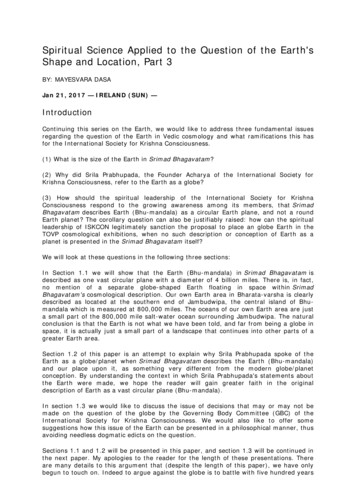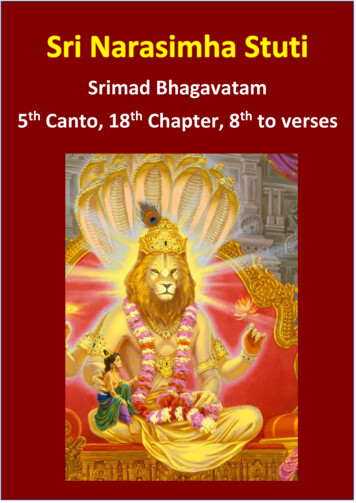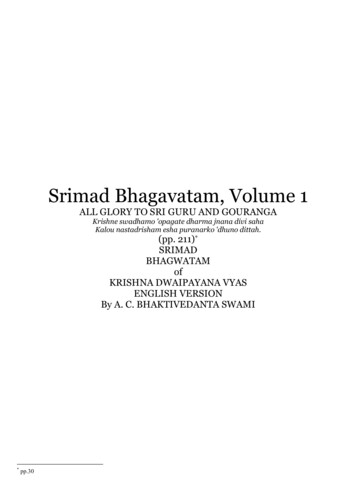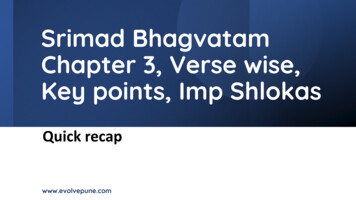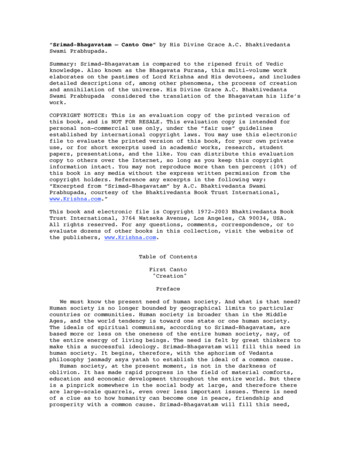
Transcription
“Srimad-Bhagavatam – Canto One” by His Divine Grace A.C. BhaktivedantaSwami Prabhupada.Summary: Srimad-Bhagavatam is compared to the ripened fruit of Vedicknowledge. Also known as the Bhagavata Purana, this multi-volume workelaborates on the pastimes of Lord Krishna and His devotees, and includesdetailed descriptions of, among other phenomena, the process of creationand annihilation of the universe. His Divine Grace A.C. BhaktivedantaSwami Prabhupada considered the translation of the Bhagavatam his life’swork.COPYRIGHT NOTICE: This is an evaluation copy of the printed version ofthis book, and is NOT FOR RESALE. This evaluation copy is intended forpersonal non-commercial use only, under the “fair use” guidelinesestablished by international copyright laws. You may use this electronicfile to evaluate the printed version of this book, for your own privateuse, or for short excerpts used in academic works, research, studentpapers, presentations, and the like. You can distribute this evaluationcopy to others over the Internet, so long as you keep this copyrightinformation intact. You may not reproduce more than ten percent (10%) ofthis book in any media without the express written permission from thecopyright holders. Reference any excerpts in the following way:“Excerpted from “Srimad-Bhagavatam” by A.C. Bhaktivedanta SwamiPrabhupada, courtesy of the Bhaktivedanta Book Trust International,www.Krishna.com.”This book and electronic file is Copyright 1972-2003 Bhaktivedanta BookTrust International, 3764 Watseka Avenue, Los Angeles, CA 90034, USA.All rights reserved. For any questions, comments, correspondence, or toevaluate dozens of other books in this collection, visit the website ofthe publishers, www.Krishna.com.Table of ContentsFirst Canto"Creation"PrefaceWe must know the present need of human society. And what is that need?Human society is no longer bounded by geographical limits to particularcountries or communities. Human society is broader than in the MiddleAges, and the world tendency is toward one state or one human society.The ideals of spiritual communism, according to Srimad-Bhagavatam, arebased more or less on the oneness of the entire human society, nay, ofthe entire energy of living beings. The need is felt by great thinkers tomake this a successful ideology. Srimad-Bhagavatam will fill this need inhuman society. It begins, therefore, with the aphorism of Vedantaphilosophy janmady asya yatah to establish the ideal of a common cause.Human society, at the present moment, is not in the darkness ofoblivion. It has made rapid progress in the field of material comforts,education and economic development throughout the entire world. But thereis a pinprick somewhere in the social body at large, and therefore thereare large-scale quarrels, even over less important issues. There is needof a clue as to how humanity can become one in peace, friendship andprosperity with a common cause. Srimad-Bhagavatam will fill this need,
for it is a cultural presentation for the respiritualization of theentire human society.Srimad-Bhagavatam should be introduced also in the schools andcolleges, for it is recommended by the great student-devotee PrahladaMaharaja in order to change the demoniac face of society.kaumara acaret prajnodharman bhagavatan ihadurlabham manusam janmatadapy adhruvam arthadam(Bhag. 7.6.1)Disparity in human society is due to lack of principles in a godlesscivilization. There is God, or the Almighty One, from whom everythingemanates, by whom everything is maintained and in whom everything ismerged to rest. Material science has tried to find the ultimate source ofcreation very insufficiently, but it is a fact that there is one ultimatesource of everything that be. This ultimate source is explainedrationally and authoritatively in the beautiful Bhagavatam, or SrimadBhagavatam.Srimad-Bhagavatam is the transcendental science not only for knowingthe ultimate source of everything but also for knowing our relation withHim and our duty toward perfection of the human society on the basis ofthis perfect knowledge. It is powerful reading matter in the Sanskritlanguage, and it is now rendered into English elaborately so that simplyby a careful reading one will know God perfectly well, so much so thatthe reader will be sufficiently educated to defend himself from theonslaught of atheists. Over and above this, the reader will be able toconvert others to accepting God as a concrete principle.Srimad-Bhagavatam begins with the definition of the ultimate source. Itis a bona fide commentary on the Vedanta-sutra by the same author, SrilaVyasadeva, and gradually it develops into nine cantos up to the higheststate of God realization. The only qualification one needs to study thisgreat book of transcendental knowledge is to proceed step by stepcautiously and not jump forward haphazardly like with an ordinary book.It should be gone through chapter by chapter, one after another. Thereading matter is so arranged with its original Sanskrit text, itsEnglish transliteration, synonyms, translation and purports so that oneis sure to become a God-realized soul at the end of finishing the firstnine cantos.The Tenth Canto is distinct from the first nine cantos because itdeals directly with the transcendental activities of the Personality ofGodhead Sri Krsna. One will be unable to capture the effects of the TenthCanto without going through the first nine cantos. The book is completein twelve cantos, each independent, but it is good for all to read themin small installments one after another.I must admit my frailties in presenting Srimad-Bhagavatam, but still Iam hopeful of its good reception by the thinkers and leaders of societyon the strength of the following statement of Srimad-Bhagavatam (1.5.11):tad-vag-visargo janatagha-viplavoyasmin prati-slokam abaddhavaty apinamany anantasya yaso 'nkitani yacchrnvanti gayanti grnanti sadhavah"On the other hand, that literature which is full with descriptions ofthe transcendental glories of the name, fame, form and pastimes of theunlimited Supreme Lord is a transcendental creation meant to bring abouta revolution in the impious life of a misdirected civilization. Suchtranscendental literatures, even though irregularly composed, are heard,sung and accepted by purified men who are thoroughly honest."
Om tat satA. C. Bhaktivedanta SwamiDated at DelhiDecember 15, 1962IntroductionThe conception of God and the conception of Absolute Truth are not onthe same level. The Srimad-Bhagavatam hits on the target of the AbsoluteTruth. The conception of God indicates the controller, whereas theconception of the Absolute Truth indicates the summum bonum or theultimate source of all energies. There is no difference of opinion aboutthe personal feature of God as the controller because a controller cannotbe impersonal. Of course modern government, especially democraticgovernment, is impersonal to some extent, but ultimately the chiefexecutive head is a person, and the impersonal feature of government issubordinate to the personal feature. So without a doubt whenever we referto control over others we must admit the existence of a personal feature.Because there are different controllers for different managerialpositions, there may be many small gods. According to the Bhagavad-gitaany controller who has some specific extraordinary power is called avibhutimat sattva, or controller empowered by the Lord. There are manyvibhutimat sattvas, controllers or gods with various specific powers, butthe Absolute Truth is one without a second. This Srimad-Bhagavatamdesignates the Absolute Truth or the summum bonum as the param satyam.The author of Srimad-Bhagavatam, Srila Vyasadeva, first offers hisrespectful obeisances unto the param satyam (Absolute Truth), and becausethe param satyam is the ultimate source of all energies, the param satyamis the Supreme Person. The gods or the controllers are undoubtedlypersons, but the param satyam from whom the gods derive powers of controlis the Supreme Person. The Sanskrit word isvara (controller) conveys theimport of God, but the Supreme Person is called the paramesvara, or thesupreme isvara. The Supreme Person, or paramesvara, is the supremeconscious personality, and because He does not derive any power from anyother source, He is supremely independent. In the Vedic literaturesBrahma is described as the supreme god or the head of all other gods likeIndra, Candra and Varuna, but the Srimad-Bhagavatam confirms that evenBrahma is not independent as far as his power and knowledge areconcerned. He received knowledge in the form of the Vedas from theSupreme Person who resides within the heart of every living being. ThatSupreme Personality knows everything directly and indirectly. Individualinfinitesimal persons, who are parts and parcels of the Supremepersonality, may know directly and indirectly everything about theirbodies or external features, but the Supreme Personality knows everythingabout both His external and internal features.The words janmady asya suggest that the source of all production,maintenance or destruction is the same supreme conscious person. Even inour present experience we can know that nothing is generated from inertmatter, but inert matter can be generated from the living entity. Forinstance, by contact with the living entity, the material body developsinto a working machine. Men with a poor fund of knowledge mistake thebodily machinery to be the living being, but the fact is that the livingbeing is the basis of the bodily machine. The bodily machine is uselessas soon as the living spark is away from it. Similarly, the originalsource of all material energy is the Supreme Person. This fact isexpressed in all the Vedic literatures, and all the exponents ofspiritual science have accepted this truth. The living force is calledBrahman, and one of the greatest acaryas (teachers), namely Sripada
Sankaracarya, has preached that Brahman is substance whereas the cosmicworld is category. The original source of all energies is the livingforce, and He is logically accepted as the Supreme Person. He istherefore conscious of everything past, present and future, and also ofeach and every corner of His manifestations, both material and spiritual.An imperfect living being does not even know what is happening within hisown personal body. He eats his food but does not know how this food istransformed into energy or how it sustains his body. When a living beingis perfect, he is aware of everything that happens, and since the SupremePerson is all-perfect, it is quite natural that He knows everything inall detail. Consequently the perfect personality is addressed in theSrimad-Bhagavatam as Vasudeva, or one who lives everywhere in fullconsciousness and in full possession of His complete energy. All of thisis clearly explained in the Srimad-Bhagavatam, and the reader has ampleopportunity to study this critically.In the modern age Lord Sri Caitanya Mahaprabhu preached the SrimadBhagavatam by practical demonstration. It is easier to penetrate into thetopics of the Srimad-Bhagavatam through the medium of Sri Caitanya'scauseless mercy. Therefore a short sketch of His life and precepts isinserted herein to help the reader understand the real merit of SrimadBhagavatam.It is imperative that one learn the Srimad-Bhagavatam from the personBhagavatam. The person Bhagavatam is one whose very life is SrimadBhagavatam in practice. Since Sri Caitanya Mahaprabhu is the AbsolutePersonality of Godhead, He is both Bhagavan and Bhagavatam in person andin sound. Therefore His process of approaching the Srimad-Bhagavatam ispractical for all people of the world. It was His wish that the SrimadBhagavatam be preached in every nook and corner of the world by those whohappened to take their birth in India.The Srimad-Bhagavatam is the science of Krsna, the AbsolutePersonality of Godhead of whom we have preliminary information from thetext of the Bhagavad-gita. Sri Caitanya Mahaprabhu has said that anyone,regardless of what he is, who is well versed in the science of Krsna(Srimad-Bhagavatam and Bhagavad-gita) can become an authorized preacheror preceptor in the science of Krsna.There is a need for the science of Krsna in human society for the goodof all suffering humanity of the world, and we simply request the leadersof all nations to pick up this science of Krsna for their own good, forthe good of society and for the good of all the world's people.A short sketch of the life and teachings of Lord Caitanya, the Preacherof Srimad-BhagavatamLord Sri Caitanya Mahaprabhu, the great apostle of love of God and thefather of the congregational chanting of the holy name of the Lord,advented Himself at Sridhama Mayapura, a quarter in the city of Navadvipain Bengal, on the Phalguni Purnima evening in the year 1407 Sakabda(corresponding to February 1486 by the Christian calendar).His father, Sri Jagannatha Misra, a learned brahmana from the districtof Sylhet, came to Navadvipa as a student because at that time Navadvipawas considered to be the center of education and culture. He domiciled onthe banks of the Ganges after marrying Srimati Sacidevi, a daughter ofSrila Nilambara Cakravarti, the great learned scholar of Navadvipa.Jagannatha Misra had a number of daughters by his wife, SrimatiSacidevi, and most of them expired at an early age. Two surviving sons,Sri Visvarupa and Visvambhara, became at last the object of theirpaternal affection. The tenth and youngest son, who was named
Visvambhara, later became known as Nimai Pandita and then, afteraccepting the renounced order of life, Lord Sri Caitanya Mahaprabhu.Lord Sri Caitanya Mahaprabhu exhibited His transcendental activitiesfor forty-eight years and then disappeared in the year 1455 Sakabda atPuri.For His first twenty-four years He remained at Navadvipa as a studentand householder. His first wife was Srimati Laksmipriya, who died at anearly age when the Lord was away from home. When He returned from EastBengal He was requested by His mother to accept a second wife, and Heagreed. His second wife was Srimati Visnupriya Devi, who bore theseparation of the Lord throughout her life because the Lord took theorder of sannyasa at the age of twenty-four, when Srimati Visnupriya wasbarely sixteen years old.After taking sannyasa, the Lord made His headquarters at JagannathaPuri due to the request of His mother, Srimati Sacidevi. The Lordremained for twenty-four years at Puri. For six years of this time Hetraveled continuously all over India (and especially throughout southernIndia) preaching the Srimad-Bhagavatam.Lord Caitanya not only preached the Srimad-Bhagavatam but propagatedthe teachings of the Bhagavad-gita as well in the most practical way. Inthe Bhagavad-gita Lord Sri Krsna is depicted as the Absolute Personalityof Godhead, and His last teachings in that great book of transcendentalknowledge instruct that one should give up all the modes of religiousactivities and accept Him (Lord Sri Krsna) as the only worshipable Lord.The Lord then assured that all His devotees would be protected from allsorts of sinful acts and that for them there would be no cause foranxiety.Unfortunately, despite Lord Sri Krsna's direct order and the teachingsof the Bhagavad-gita, less intelligent people misunderstand Him to benothing but a great historical personality, and thus they cannot acceptHim as the original Personality of Godhead. Such men with a poor fund ofknowledge are misled by many nondevotees. Thus the teachings of theBhagavad-gita were misinterpreted even by great scholars. After thedisappearance of Lord Sri Krsna there were hundreds of commentaries onthe Bhagavad-gita by many erudite scholars, and almost every one of themwas motivated by self-interest.Lord Sri Caitanya Mahaprabhu is the selfsame Lord Sri Krsna. Thistime, however, He appeared as a great devotee of the Lord in order topreach to the people in general, as well as to religionists andphilosophers, about the transcendental position of Sri Krsna, theprimeval Lord and the cause of all causes. The essence of His preachingis that Lord Sri Krsna, who appeared at Vrajabhumi (Vrndavana) as the sonof the King of Vraja (Nanda Maharaja), is the Supreme Personality ofGodhead and is therefore worshipable by all. Vrndavana-dhama isnondifferent from the Lord because the name, fame, form and place wherethe Lord manifests Himself are all identical with the Lord as absoluteknowledge. Therefore Vrndavana-dhama is as worshipable as the Lord. Thehighest form of transcendental worship of the Lord was exhibited by thedamsels of Vrajabhumi in the form of pure affection for the Lord, andLord Sri Caitanya Mahaprabhu recommends this process as the mostexcellent mode of worship. He accepts the Srimad-Bhagavata Purana as thespotless literature for understanding the Lord, and He preaches that theultimate goal of life for all human beings is to attain the stage ofprema, or love of God.Many devotees of Lord Caitanya like Srila Vrndavana dasa Thakura, SriLocana dasa Thakura, Srila Krsnadasa Kaviraja Gosvami, Sri Kavikarnapura,Sri Prabodhananda Sarasvati, Sri Rupa Gosvami, Sri Sanatana Gosvami, SriRaghunatha Bhatta Gosvami, Sri Jiva Gosvami, Sri Gopala Bhatta Gosvami,
Sri Raghunatha dasa Gosvami and in this latter age within two hundredyears, Sri Visvanatha Cakravarti, Sri Baladeva Vidyabhusana, SriSyamananda Gosvami, Sri Narottama dasa Thakura, Sri Bhaktivinoda Thakuraand at last Sri Bhaktisiddhanta Sarasvati Thakura (our spiritual master)and many other great and renowned scholars and devotees of the Lord haveprepared voluminous books and literatures on the life and precepts of theLord. Such literatures are all based on the sastras like the Vedas,Puranas, Upanisads, Ramayana, Mahabharata and other histories andauthentic literatures approved by the recognized acaryas. They are uniquein composition and unrivaled in presentation, and they are full oftranscendental knowledge. Unfortunately the people of the world are stillignorant of them, but when these literatures, which are mostly inSanskrit and Bengali, come to light the world and when they are presentedbefore thinking people, then India's glory and the message of love willoverflood this morbid world, which is vainly searching after peace andprosperity by various illusory methods not approved by the acaryas in thechain of disciplic succession.The readers of this small description of the life and precepts of LordCaitanya will profit much to go through the books of Srila Vrndavana dasaThakura (Sri Caitanya-bhagavata) and Srila Krsnadasa Kaviraja Gosvami(Sri Caitanya-caritamrta). The early life of the Lord is mostfascinatingly expressed by the author of Caitanya-bhagavata, and as faras the teachings are concerned, they are more vividly explained in theCaitanya-caritamrta. Now they are available to the English-speakingpublic in our Teachings of Lord Caitanya.The Lord's early life was recorded by one of His chief devotees andcontemporaries, namely Srila Murari Gupta, a medical practitioner of thattime, and the latter part of the life of Sri Caitanya Mahaprabhu wasrecorded by His private secretary Sri Damodara Gosvami, or Srila SvarupaDamodara, who was practically a constant companion of the Lord at Puri.These two devotees recorded practically all the incidents of the Lord'sactivities, and later on all the books dealing with the Lord, which areabove mentioned, were composed on the basis of kadacas (notebooks) bySrila Damodara Gosvami and Murari Gupta.So the Lord advented Himself on the Phalguni Purnima evening of 1407Sakabda, and it was by the will of the Lord that there was a lunareclipse on that evening. During the hours of eclipse it was the custom ofthe Hindu public to take bath in the Ganges or any other sacred river andchant the Vedic mantras for purification. When Lord Caitanya was bornduring the lunar eclipse, all India was roaring with the holy sound ofHare Krsna, Hare Krsna, Krsna Krsna, Hare Hare. Hare Rama, Hare Rama,Rama Rama, Hare Hare. These sixteen names of the Lord are mentioned inmany Puranas and Upanisads, and they are described as the Taraka-brahmanama of this age. It is recommended in the sastras that offenselesschanting of these holy names of the Lord can deliver a fallen soul frommaterial bondage. There are innumerable names of the Lord both in Indiaand outside, and all of them are equally good because all of themindicate the Supreme Personality of Godhead. But because these sixteenare especially recommended for this age, people should take advantage ofthem and follow the path of the great acaryas who attained success bypracticing the rules of the sastras (revealed scriptures).The simultaneous occurrence of the Lord's appearance and the lunareclipse indicated the distinctive mission of the Lord. This mission wasto preach the importance of chanting the holy names of the Lord in thisage of Kali (quarrel). In this present age quarrels take place even overtrifles, and therefore the sastras have recommended for this age a commonplatform for realization, namely chanting the holy names of the Lord.People can hold meetings to glorify the Lord in their respective
languages and with melodious songs, and if such performances are executedin an offenseless manner, it is certain that the participants willgradually attain spiritual perfection without having to undergo morerigorous methods. At such meetings everyone, the learned and the foolish,the rich and the poor, the Hindus and the Muslims, the Englishmen and theIndians, and the candalas and the brahmanas, can all hear thetranscendental sounds and thus cleanse the dust of material associationfrom the mirror of the heart. To confirm the Lord's mission, all thepeople of the world will accept the holy name of the Lord as the commonplatform for the universal religion of mankind. In other words, theadvent of the holy name took place along with the advent of Lord SriCaitanya Mahaprabhu.When the Lord was on the lap of His mother, He would at once stopcrying as soon as the ladies surrounding Him chanted the holy names andclapped their hands. This peculiar incident was observed by the neighborswith awe and veneration. Sometimes the young girls took pleasure inmaking the Lord cry and then stopping Him by chanting the holy name. Sofrom His very childhood the Lord began to preach the importance of theholy name. In His early age Lord Sri Caitanya was known as Nimai. Thisname was given by His beloved mother because the Lord took His birthbeneath a nimba tree in the courtyard of His paternal house.When the Lord was offered solid food at the age of six months in theanna-prasana ceremony, the Lord indicated His future activities. At thistime it was customary to offer the child both coins and books in order toget some indication of the future tendencies of the child. The Lord wasoffered on one side coins and on the other the Srimad-Bhagavatam. TheLord accepted the Bhagavatam instead of the coins.When He was a mere baby crawling in the yard, one day a snake appearedbefore Him, and the Lord began to play with it. All the members of thehouse were struck with fear and awe, but after a little while the snakewent away, and the baby was taken away by His mother. Once He was stolenby a thief who intended to steal His ornaments, but the Lord took apleasure trip on the shoulder of the bewildered thief, who was searchingfor a solitary place in order to rob the baby. It so happened that thethief, wandering hither and thither, finally arrived just before thehouse of Jagannatha Misra and, being afraid of being caught, dropped thebaby at once. Of course the anxious parents and relatives were glad tosee the lost child.Once a pilgrim brahmana was received at the house of Jagannatha Misra,and when he was offering food to the Godhead, the Lord appeared beforehim and partook of the prepared food. The eatables had to be rejectedbecause the child touched them, and so the brahmana had to make anotherpreparation. The next time the same thing happened, and when thishappened repeatedly for the third time, the baby was finally put to bed.At about twelve at night when all the members of the house were fastasleep within their closed rooms, the pilgrim brahmana offered hisspecially prepared foods to the Deity, and, in the same way, the babyLord appeared before the pilgrim and spoiled his offerings. The brahmanathen began to cry, but since everyone was fast asleep, no one could hearhim. At that time the baby Lord appeared before the fortunate brahmanaand disclosed His identity as Krsna Himself. The brahmana was forbiddento disclose this incident, and the baby returned to the lap of Hismother.There are many similar incidents in His childhood. As a naughty boy Hesometimes used to tease the orthodox brahmanas who used to bathe in theGanges. When the brahmanas complained to His father that He was splashingthem with water instead of attending school, the Lord suddenly appearedbefore His father as though just coming from school with all His school
clothes and books. At the bathing ghata He also used to play jokes on theneighboring girls who engaged in worshiping Siva in hopes of getting goodhusbands. This is a common practice amongst unmarried girls in Hindufamilies. While they were engaged in such worship, the Lord naughtilyappeared before them and said, "My dear sisters, please give Me all theofferings you have just brought for Lord Siva. Lord Siva is My devotee,and Parvati is My maidservant. If you worship Me, then Lord Siva and allthe other demigods will be more satisfied." Some of them refused to obeythe naughty Lord, and He would curse them that due to their refusal theywould be married to old men who had seven children by their previouswives. Out of fear and sometimes out of love the girls would also offerHim various goods, and then the Lord would bless them and assure themthat they would have very good young husbands and that they would bemothers of dozens of children. The blessings would enliven the girls, butthey used often to complain of these incidents to their mothers.In this way the Lord passed His early childhood. When He was justsixteen years old He started His own catuspathi (village school conductedby a learned brahmana). In this school He would simply explain Krsna,even in readings of grammar. Srila Jiva Gosvami, in order to please theLord, later composed a grammar in Sanskrit, in which all the rules ofgrammar were explained with examples that used the holy names of theLord. This grammar is still current. It is known as Hari-namamrtavyakarana and is prescribed in the syllabus of schools in Bengal.During this time a great Kashmir scholar named Kesava Kasmiri came toNavadvipa to hold discussions on the sastras. The Kashmir pandita was achampion scholar, and he had traveled to all places of learning in India.Finally he came to Navadvipa to contest the learned panditas there. Thepanditas of Navadvipa decided to match Nimai Pandita (Lord Caitanya) withthe Kashmir pandita, thinking that if Nimai Pandita were defeated, theywould have another chance to debate with the scholar, for Nimai Panditawas only a boy. And if the Kashmir pandita were defeated, then they wouldeven be more glorified because people would proclaim that a mere boy ofNavadvipa had defeated a champion scholar who was famous throughoutIndia. It so happened that Nimai Pandita met Kesava Kasmiri whilestrolling on the banks of the Ganges. The Lord requested him to compose aSanskrit verse in praise of the Ganges, and the pandita within a shorttime composed a hundred slokas, reciting the verses like a storm andshowing the strength of his vast learning. Nimai Pandita at oncememorized all the slokas without an error. He quoted the sixty-fourthsloka and pointed out certain rhetorical and literary irregularities. Heparticularly questioned the pandita's use of the word bhavani-bhartuh. Hepointed out that the use of this word was redundant. Bhavani means thewife of Siva, and who else can be her bharta, or husband? He also pointedout several other discrepancies, and the Kashmir pandita was struck withwonder. He was astonished that a mere student of grammar could point outthe literary mistakes of an erudite scholar. Although this matter wasended prior to any public meeting, the news spread like wildfire all overNavadvipa. But finally Kesava Kasmiri was ordered in a dream bySarasvati, the goddess of learning, to submit to the Lord, and thus theKashmir pandita became a follower of the Lord.The Lord was then married with great pomp and gaiety, and at this timeHe began to preach the congregational chanting of the holy name of, theLord at Navadvipa. Some of the brahmanas became envious of Hispopularity, and they put many hindrances on His path. They were sojealous that they finally took the matter before the Muslim magistrate atNavadvipa. Bengal was then governed by Pathans, and the governor of theprovince was Nawab Hussain Shah. The Muslim magistrate of Navadvipa tookup the complaints of the brahmanas seriously, and at first he warned the
followers of Nimai Pandita not to chant loudly the name of Hari. But LordCaitanya asked His followers to disobey the orders of the Kazi, and theywent on with their sankirtana (chanting) party as usual. The magistratethen sent constables who interrupted a sankirtana and broke some of themrdangas (drums). When Nimai Pandita heard of this incident He organizeda party for civil disobedience. He is the pioneer of the civildisobedience movement in India for the right cause. He organized aprocession of one hundred thousand men with thousands of mrdangas andkaratalas (hand cymbals), and this procession passed over the roads ofNavadvipa in defiance of the Kazi who had issued the order. Finally theprocession reached the house of the Kazi, who went upstairs out of fearof the masses. The great crowds assembled at the Kazi's house displayed aviolent temper, but the Lord asked them to be peaceful. At this time
Srimad-Bhagavatam begins with the definition of the ultimate source. It is a bona fide commentary on the Vedanta-sutra by the same author, Srila Vyasadeva, and gradually it develops into nine cantos up to the highest state of God realization. The only qualification one needs to study this

